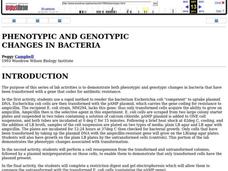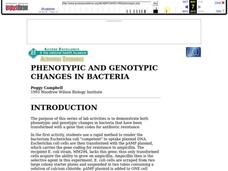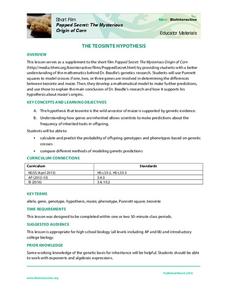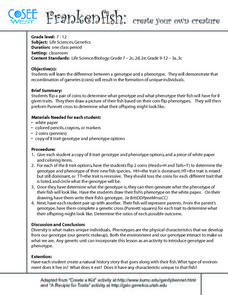Curated OER
Phenotypic and Genotypic Changes in Bacteria
Students investigate a rapid method to render the bacterium Escherichia coli "competent" to uptake plasmid DNA. They demonstrate the phenotypic changes associated with transformation. They perform a cell resuspension from the...
Curated OER
"Easter" Egg Genetics
Using plastic Easter eggs to represent parent phenotypes, genetics enthusiasts simulate the passing of alleles. They record the phenotype of each half of the egg, one representing the mother's and one representing the father's. They...
Curated OER
PHENOTYPIC AND GENOTYPIC CHANGES IN BACTERIA
Students use a rapid method to render the bacterium Escherichia coli "competent" in order to uptake plasmid DNA. They also have growth on the plain LB plates by the untransformed cells (which serve as controls). Students perform a cell...
Curated OER
Science Lesson for Grade 12
Twelfth graders perform dihybrid crosses and calculate phenotype and genotype ratios. In this series of science lessons, 12th graders explain the process of anodizing aluminum. They research on the benefits and harm caused by resonance...
Curated OER
Just Like Me
Students review genetic concept of traits, define and discuss phenotypes and genotypes, examine differences between single gene traits and multiple gene traits, and compare and record phenotypes with every other student in class.
Curated OER
Punnett Squares
Eighth graders take a short quiz on genotypes and phenotypes. As a class, they are introduced to the concept of Punnett Squares and listen to a description of Gregor Mendel's pea experiment. In groups, they complete Punnett Squares to...
Curated OER
Inheritance in Maize
Learners use mutant corn ears to investigate inheritance patterns. In this inheritance lesson plan, students count the number of corn kernels of each phenotype in mutant and wild type ears of corn. Learners calculate the ratio of...
Howard Hughes Medical Institute
The Teosinte Hypothesis
Don't want to sound corny, but your class will be a-maize-d by an engaging activity! Explore the history of the modern corn plant through a video and Punnett squares. Junior genetics experts get hands-on experience with actual research...
Curated OER
Making Babies
Students participate in a genetics activity in which they determine genotypes and phenotypes for given traits. They work with a partner and create babies based on their genotypes. Once traits for babies are determined, they write...
Curated OER
Frankenfish
Students learn the difference between a genotype and a phenotype. They demonstrate that recombination of gametes (coins) will result in the formation of unique individuals.
Beyond Benign
Punnett Square Possibilities
Discover possible genetic outcomes through Punnett Squares. Learners continue studying genetic traits in the 10th lesson in the 17-part series. After determining the father of Sparky's kittens, scholars now attempt to predict the traits...
Curated OER
Wearing My Genes: Basic Principles of Heredity
Students explore heredity. In this science lesson plan, students examine what heredity is, distinguish the difference between the dominant and recessive genes, explain the difference between phenotype and genotype, and predict the...
Curated OER
Happy Face Spider Propagation
Students research genetic adaptations. In this chromosome lesson, students investigate dominant and recessive genes using spiders indigenous to Hawaii. Students create Punnett squares to determine the probability of passing specific...
LABScI
Genetic Equilibrium: Human Diversity
Investigate the Hardy-Weinberg Principle to explain genetic equilibrium. The 10th lesson plan of a series of 12 is a laboratory exploration of genetic equilibrium. Your classes use a mixture of beans to model allele and genotype...
Curated OER
Natural Selection
Young scholars practice calculating allele and genotype frequencies in the framework of a simple simulation using hard candy, calculators, and a worksheet. This lesson includes a three-page worksheet and an assessment question for...
Curated OER
A Sputtering Image
Students explain the role of genes in heredity. In this biology activity, students predict the offspring's genotypes and phenotypes using the Punnett Square. They compute the probability of genotypes and phenotypes.
Curated OER
Here's Looking at You
Students assess some common inherited traits which are easily observable and note their phenotype for the trait. Students compare their phenotypes to those of their parents and attempt to describe the pattern and manor of inheritance.
Curated OER
The Genetics of Parenthood
Students explore the field of genetics. Through a graphing activity, students assess four common traits. They complete a Meiosis I and II charts which represent possible gametes for an individual. Students discuss phenotype and...
Science 4 Inquiry
Monster Mash-Up of Genetics
It's alive! Young mad scientists create monsters as they explore the probabilities of genetic traits during a well-structured inquiry activity. Pairs travel from station to station, rolling the dice and adding traits to their creations...
Curated OER
I Dream of Genome
High school learners identify chemical and structural properties of DNA and explain the differences between genotype and phenotype. They develop a scientific investigation to determine the ethnic heritage of a large group of people.
North Carolina State University
Exploring Genetics Across the Middle School Science and Math Curricula
Where is a geneticist's favorite place to swim? A gene pool. Young geneticists complete hands-on activities, experiments, and real-world problem solving throughout the unit. With extra focus on dominant and recessive genes, Punnett...
Curated OER
Ladders of Life
Students explore the field of genetics. They examine four basic traits. Students demonstrate their knowledge of phenotype and genotype by charting their personal traits. Students compelte a Meiosis chart. From the chart results,...
Curated OER
Heredity Mix 'n Match
Students randomly select jelly beans that represent genes for several human traits such as tongue-rolling ability and eye color. Then, working in pairs (preferably of mixed gender), students randomly choose new pairs of jelly beans from...
Curated OER
People Are Like Peas in a Pod
Students experiment with pea pods to observe/appreciate the diversity of individuals within a population, and to explain of how dominant and recessive traits, genotypes, and phenotypes help produce variation in a population.
Other popular searches
- Genotype and Phenotype
- Genotype Phenotype
- Genotype Phenotype Earlobe
- Phenotype Genotype Lab
- Human Phenotype and Genotype
- Genotype Phenotype Worksheet
- Phenotype + Genotype Lab
- Phenotype Genotype Worksheets























